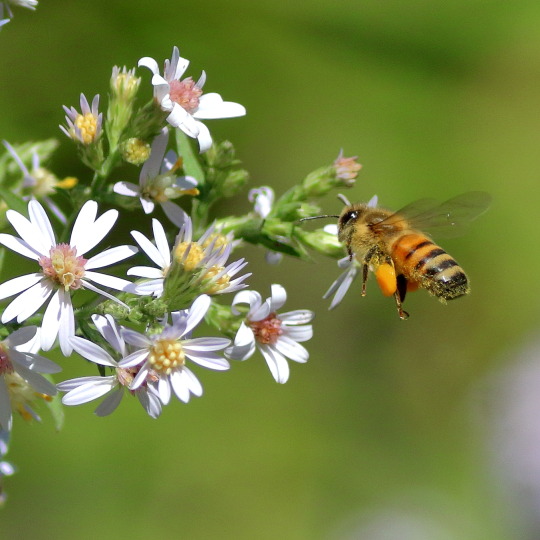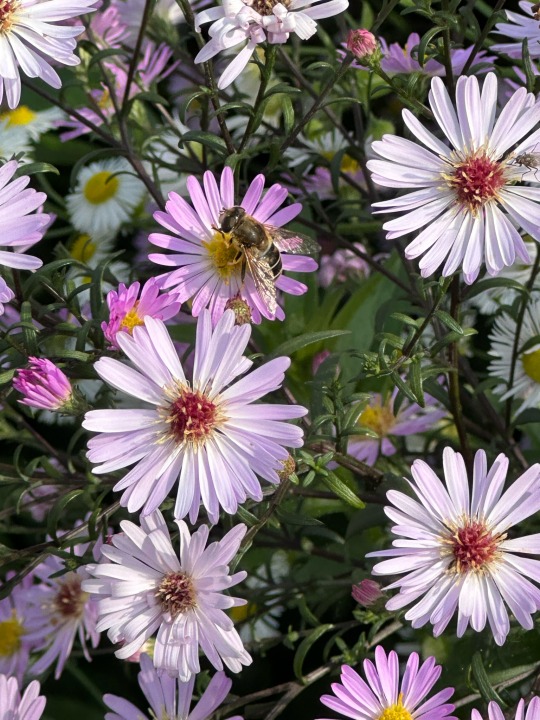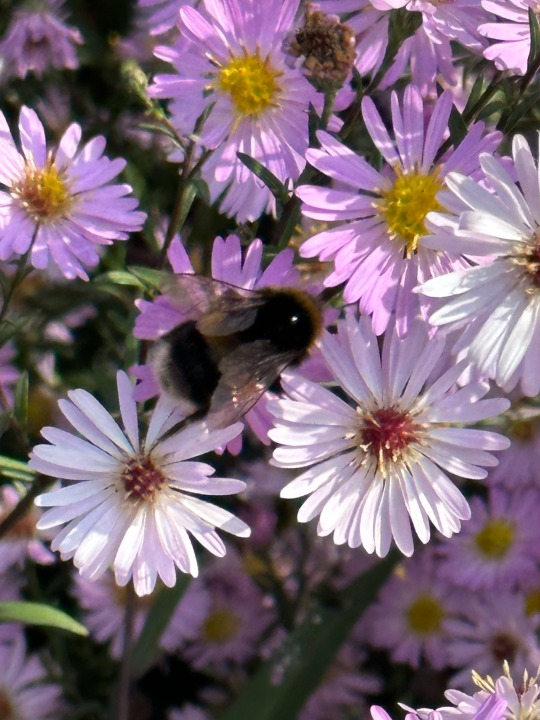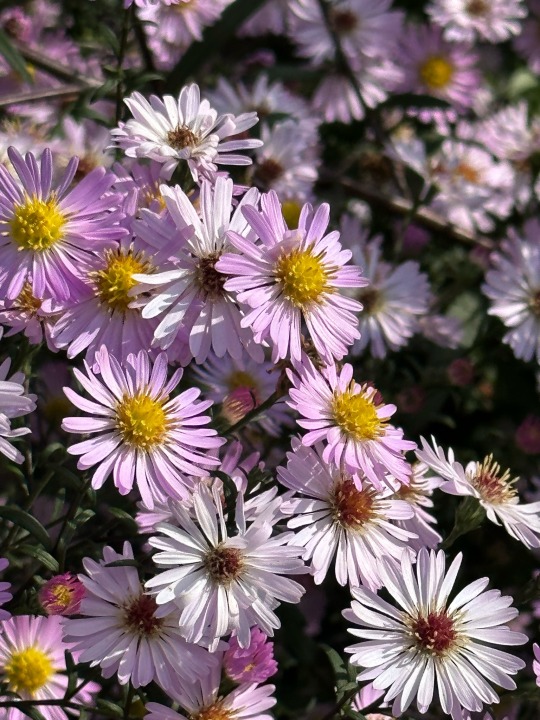#aster with pollinators
Explore tagged Tumblr posts
Text
Colorful Climbing Asters Attract All Types of Little Pollinators
Aster and Skipper Climbing asters (Ampelaster carolinianus) are one of the most common and beautiful fall blooming flowers that grow in our wetlands. As their name implies, they love to climb anything that they get near, so come fall, there are carpets of bright pink flowers covering fences, trees, other shrubs, and even patches of ground if there is nothing to climb. And covering all those…
#aster flowers#aster photographs#aster photography#aster with pollinators#beautiful asters#brown skippers#climbing asters#colorful asters#fall asters#fall skippers#Florida skippers#long winged skipper#Ocola skipper#pink asters#skipper butterflies#skipper photographs#skipper photography#skippers
0 notes
Text


White Heath Aster starts to bloom now. Bees busily harvest its pollen.
But there is a melancholy to this flower. It's one of the very last things which bloom in the Midwest.
Soon, everything in the forest will start to die and nothing new will come until the spring.
#midwest#wildlife photography#nature photography#wildlife photos#bees#bee#pollinators#aster#white aster#white heath aster#summertime#beeblr#original photography#original photographers
359 notes
·
View notes
Text


Chicago Botanic Garden, September
#honeybee#purple aster#pollinators#asters#naturecore#cottagecore#cozy cottage#gardencore#nature#plantcore#plants#flowers#chicago botanic garden#wildflowers
32 notes
·
View notes
Text




Plant of the Day
Saturday 30 September 2023
A clump-forming perennial Symphyotrichum 'Prairie Sky' has small pinky mauve flowerheads with centres that have a paler shading. The flowers were popular with the local bees.
Jill Raggett
#Symphyotrichum#aster#bee friendly#pollinators#herbaceous#perennial#plants#horticulture#gardens#garden#essex#Beth Chatto#herbaceousperennial
161 notes
·
View notes
Text

Vanessa cardui on Aster ageratoides / Painted Lady on Balsam Aster at the Sarah P. Duke Gardens at Duke University in Durham, NC
#Vanessa cardui#Vanessa#nymphalidae#Lepidoptera#Aster ageratoides#Aster#Asteraceae#painted lady#Balsam Aster#Native pollinators#Native insects#Pollinators#Insects#butterflies#Plants#Flowers#Nature photography#photography#photographers on tumblr#Sarah P. Duke Gardens#Duke Gardens#Duke University#Durham#Durham NC#north carolina#🌺🌻
31 notes
·
View notes
Text

Beez in the trap
🐞🍂🐛 also find me on instagram and ko-fi! 🌻🦋🐝
#nature#nature photography#photography#flowers#floral#summer#naturecore#summer flowers#bees#bumble bee#bumblebee#save the bees#pollinators#pink flowers#new england aster#asters
29 notes
·
View notes
Text

Pearl Crescent and New England Aster
7 notes
·
View notes
Text

US 2017 Honey Bee on New England Aster
#us#usa#2010s#honey bee#bee#insects#aster#flower#protect pollinators#animals#forever stamps#stamp#stamps#philately#stamp collection#snail mail#postage#postage stamp#usps
5 notes
·
View notes
Text

I posted some pictures of bumble bees on the New England asters
#pollinators#bees#bumble bees#asters#native plants#native plant gardening#photography#macro photography#insects#bugblr
24 notes
·
View notes
Text
starting a horticulture program and rapidly learning that mainstream hort culture sees plants as toys, decoration, and maybe food sometimes, and not as living things that exist as part of an ecosystem to whom we have a responsibility as a species. it’s very uncomfortable
#someone pulled up a weed while we were dividing shastas#pulled up an id app and read out that it was an aster and a 'favorite of pollinators'#and someone scoffed and said i'm pretty sure if it's a flower bees will love it#same person in another class said 'who would plant solidago'#and breeds hybrid daylilies#the earth gave us asters and goldenrod and instead of being grateful we talk about it like it's trash and replace it with sterile 'vars...#just a completely alien way of thinking to me
5 notes
·
View notes
Text
OCTOBER BLOOM DAY 2023

View On WordPress
#asters#autumn#bees#blooms#fall#flowers#gaillardia#Garden Bloggers’ Bloom Day#GBBD#Japanese anemone#mums#October#pollinators
0 notes
Text
Sharing Can Often Be a Great Thing
Crescent and Bee Last week on my way home I discovered a beautiful climbing aster bush on the banks of the Wacassassa River. When I stopped to take some photos of it, I realized that not only was it loaded with flowers, but those flowers were loaded with pollinators. There were tons of bees and wasps, which I expected, but I was surprised to discover quite a few butterflies, too. It’s getting…
#brushfooted butterflies#butterfly photographs#butterfly photography#climbing asters#colorful butterflies#fall asters#fall butterflies#fall honey bees#honey bee photographs#honey bee photography#honey bees#honey bees on flowers#pearl crescent#pearl crescent butterfly#pink asters#western honey bees#wildflower photographs#wildflower photography#wildflowers#wildflowers with pollinators
0 notes
Text

Still lots to enjoy even if the autumnal equinox is just around the corner!
0 notes
Text
Need help growing Wildflowers
I got some Native Wildflower seeds from the city to support pollinators but the packet has a QR code for the instructions.
So annoying! Not everyone has a QR reader readily available to them.
I'll assume it's too late in the year to plant them anyway (It's July now).
Packet contains:
Common Milkweed
Lance-leaved Coreopsis
Sweet Joe Pye Weed
Sneezeweed
Sweet Ox-Eye
Evening Primrose
Grey-headed Coneflower
Stiff Goldenrod
Arrow-leaved Aster
Hoary Vervain
#wildflowers#support pollinators#bees#butterflies#monarch butterfly#qr code#environment#flowers#plants#personal#Common Milkweed#Lance-leaved Coreopsis#Sweet Joe Pye Weed#Sneezeweed#Sweet Ox-Eye#Evening Primrose#Grey-headed Coneflower#Stiff Goldenrod#Arrow-leaved Aster#Hoary Vervain
0 notes
Text

Bombus impatiens on Aster tataricus 'Jin Dai' / Common Eastern Bumblebee on 'Jin Dai' Tartarian Aster at the Sarah P. Duke Gardens at Duke University in Durham, NC
#Bombus impatiens#Bombus#apidae#Aster tataricus 'Jin Dai'#Aster tataricus#Jin Dai Tartarian Aster#Tartarian Aster#Aster#Asteraceae#Native bees#Native pollinators#bumblebees#Bees#Pollinators#Plants#Flowers#Nature photography#photography#photographers on tumblr#Sarah P. Duke Gardens#Duke Gardens#Duke University#Durham#Durham NC#north carolina#🌺🌻
17 notes
·
View notes
Text


Buzzing around the asters
#nature#photography#nature photography#spring#spring flowers#floral#flowers#pollinators#bees#white flowers#aster#asters
38 notes
·
View notes